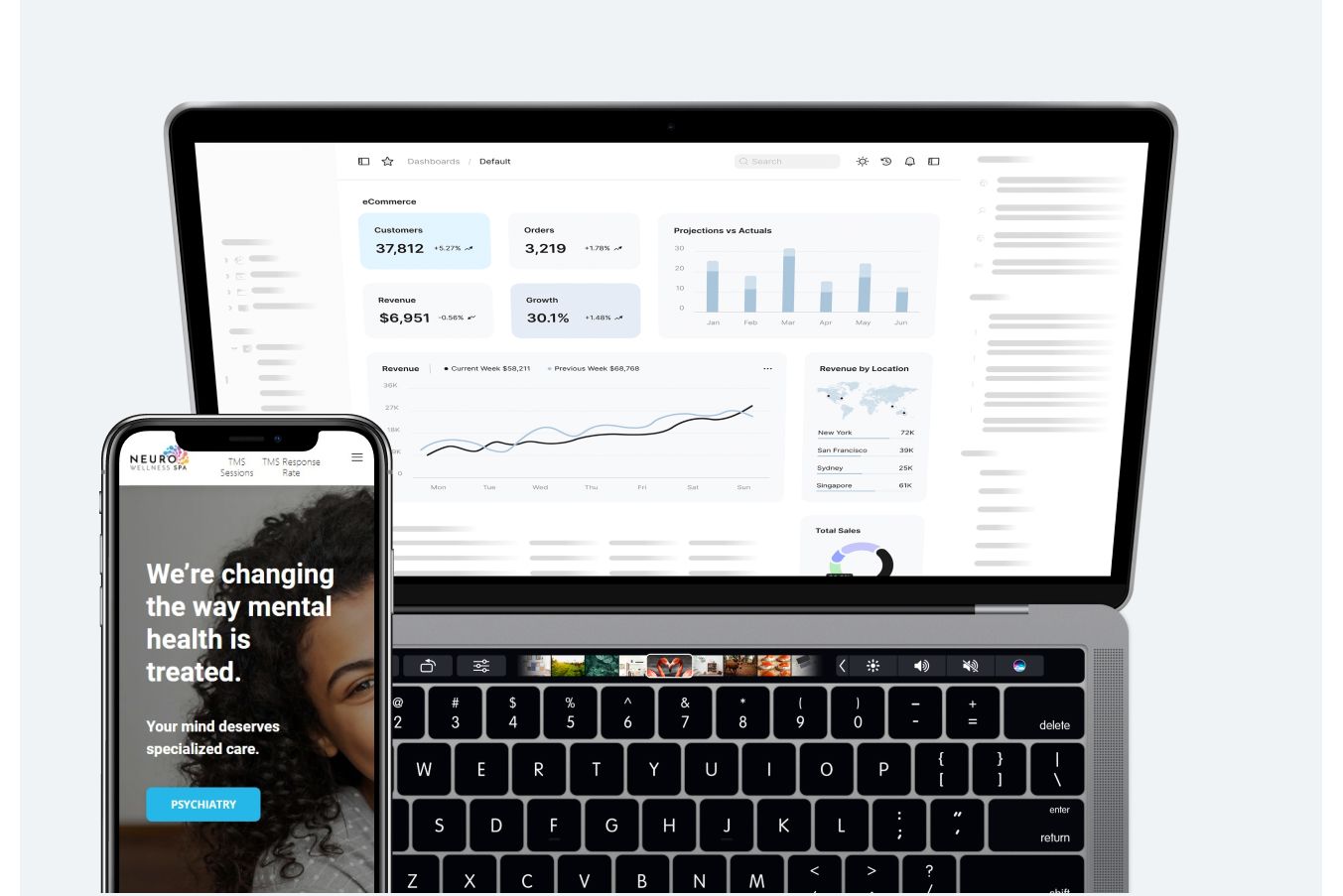
Treatment Center Marketing: Generate Drug Rehab Leads with Local SEO
Digital Marketing Tips For Rehab Centers
Let’s cut through the noise: If your treatment center isn’t focusing on Google Business Profile – you’re leaving admissions on the table. In fact, it’s not uncommon for over 50% of addiction treatment admissions to come from Google Maps.
Local SEO isn’t a box to check: it’s your most powerful growth engine. I’ve seen facilities double calls just by shifting their SEO strategy from statewide to hyperlocal. And I’ve also seen centers with solid call numbers make the wrong strategy pivots because they didn’t have the right attribution or tracking in place
(do you know how many admissions come from Google Maps vs your website?)
Well, this guide is built for you – and treatment centers that are serious about growing admissions and doing it the right way. We all know Google Ads isn’t sustainable in this space (it’s insanely expensive). Apply some of the tips below and you’ll be able to generate more drug rehab leads with far lower spend!
Rather listen instead? You can hear all of the following tips and more on Sam’s interview on the Recovery Reach Podcast:
Why Most Treatment Center SEO Strategies Miss the Mark
It’s common for addiction treatment centers to want to rank statewide—or even nationally. After all, people travel for care, right?
Yes, but here’s the truth:
Local intent search = Map Pack first.
And if you’re not in the Map Pack, you’re not the first (or second, or third) thing people see.
If someone in Columbus searches for “medical detox near me”, they’re going to see three local results in a map. Even if your facility ranks #1 organically, it’s still showing up below those three. On mobile, that means you’re off the screen—and out of sight means out of mind.
The Pitfall of “Going Statewide”
Focusing too broadly means:
- You lose local relevance
- You miss the Map Pack
- You don’t win statewide or locally
When I was the digital marketing director for a multi-location facility in Ohio, we shifted from statewide to city-first. The result? 12–15% year-over-year growth in call volume without additional spend.
The 3 Google Local SEO Ranking Factors
Google has three core ranking factors for local search. Understanding these isn’t optional—it’s critical.
1. Distance
You can’t fake this. Google prioritizes proximity. If your facility is in West LA, you won’t show up in the Map Pack for East LA unless you do some serious lifting (or move).
2. Relevance
This is all about your content. If you want to rank for “Residential Rehab in Los Angeles”, you need a page that says exactly that. “Residential Treatment” alone won’t cut it.
Quick Tip: Put your city in the H1s, title tags, and slugs.
“Medical Detox”–> “Medical Detox Phoenix”
“IOP” –> “IOP Program Los Angeles”
3. Prominence
This is your authority. It’s built from:
- Reviews (especially on Google)
- Branded searches
- Driving directions requests
- Media mentions
- Backlinks
- Social presence
Google tracks how many people are engaging with your brand—even before they click your website. So yes, even PR and brand awareness campaigns can help in Local SEO.
Want to Rank in the Map Pack? Start Here
These aren’t fluff. These are battle-tested strategies we implement at Hoopless to help our treatment center clients dominate their local markets:
✅ Optimize Your Google Business Profile (GBP)
- Fill out every field (yes, even the ones buried under “Info” and “Services”)
- Use at least 5 categories, up to 10 if relevant
Examples: Addiction Treatment Center, Alcoholism Treatment Program, Mental Health Service, Psychiatric Hospital, Counselor, Psychiatrist, Psychologist - Add all relevant services—especially the ones Google auto-suggests in GBP
- Use a dedicated tracking number (see below)
- Add images, description, and hours
- Embed driving directions on your website for each location
Advanced Tip: Use Service Area Pages (The Right Way)
Want to rank just outside your physical location? Build dedicated location pages for nearby neighborhoods or towns. But don’t pretend you’re located there (Google hates that, and so do users).
Example:
Page Title: “Addiction Treatment near Smithfield”
Body Copy: “Located just 15 minutes south of Smithfield…”
[Embed Google Maps Driving directions!]
Be honest. Be specific. Use map embeds and driving directions.
Use Grid Rank Tracking to See the Real Picture
If you’re searching on Google from your treatment center and see your facility in the Map Pack: that doesn’t really mean anything. Because distance is a factor, you’re pretty much always going to rank first for all sorts of keywords from your facility. But two blocks away? That might be a completely different story.

Tools like Local Falcon or Localo show you where you rank across different parts of your city—not just a single search result.
You might be #1 in South Phoenix, but #15 in North Phoenix. That means half your market can’t even see you.
These grid scans give you tactical insight into where to double down or where to build location pages.
Attribution: Don’t Guess Where Your Leads Are Coming From
This is where most treatment centers—and even agencies—get it wrong.
If you’re relying only on Google Analytics or G4 to understand how SEO is performing, you’re missing 60–70% of the picture.
Why?
Because many calls never hit your website.
They come straight from your Google Business Profile.
How to Fix That: Call Tracking Metrics + Dynamic Number Insertion
If you take one technical thing away from this post, make it this.
✅ Use a unique tracking number for your Google Business Profile
This is the only way to track calls that come directly from the Map Pack.
- Use a number not found anywhere else on your site
- It should forward to your main line
- Track it as a separate source in your call tracking platform
✅ Add UTM parameters to your GBP website link
This powers dynamic number insertion (DNI) when someone clicks from GBP and lands on your site.
Example:
https://yourtreatmentcenter.com/?utm_source=google&utm_medium=organic&utm_campaign=gmb
It also will let you track keyword click and impressions in Google Search Console! Just filter by pages and select the URL that shows the UTM parameter. Now you can differentiate homepage traffic from Google Maps traffic.
✅ Use DNI in Call Tracking Metrics (CTM) or CallRail
When someone lands on your site with the UTM above, you can swap the phone number on the page to match the source with DNI.
This tells you:
- They found you through local search
- They clicked your GBP link
- They called after reviewing your website
You now know exactly what part of your SEO strategy drove the call.
What Gets Measured Gets Managed
At Hoopless, we don’t just “do SEO.” We track:
- Map Pack presence across your service area
- Call volume by source (Map Pack vs. website)
- Keyword performance by location
- Click-to-call rate
- Call quality and lead outcomes
If you’re not measuring what matters, you’re probably overvaluing vanity metrics like traffic and rankings—while undervaluing the stuff that’s actually driving revenue.
Step Up Your Treatment Center’s Marketing With Local SEO
Local SEO for treatment centers isn’t about traffic. It’s about calls, admissions, and impact.
If you’ve got a physical location and a solid program, you’re already halfway there. Now it’s time to win the Map Pack (and clients will follow).
Want help implementing all of this?
We build and manage local SEO campaigns specifically for behavioral health and treatment centers. From building beautifully on-brand websites to fully managed SEO and Google Ads campaigns (yes, we help handle LegitScript), you can get a fractional full-service digital marketing department without the added employee overhead.
Reach out today to book a free discovery call.

Sam Knight
Sam Knight is the Co-Founder of Hoopless, where he heads up strategy & operations. Sam has been actively practicing SEO for over a decade and is an official Platinum Product Expert for Google Business Profile (previously known as Google My Business). You can find him actively posting on the GBP Help Community where he’s assisted over 1,000 merchants.
